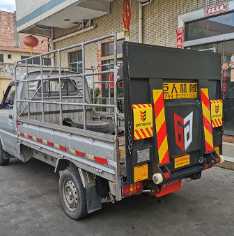
When installing tailboards on new energy vehicles, it is necessary to fully consider the special characteristics of battery life and power distribution to ensure that the overall performance of the vehicle is not greatly affected.
From the perspective of battery life, the range of new energy vehicles is already constrained by various factors such as battery capacity, driving habits, and road conditions, and the use of tailboards undoubtedly increases additional power consumption. Firstly, the power level of the tailboard needs to be considered. Different models and specifications of tailboards have varying power requirements during operation. The high-power tailgate will quickly consume battery power during the lifting process. If the vehicle's battery capacity is limited, frequent use of the tailgate may significantly shorten the vehicle's range. Secondly, the degree of battery aging cannot be ignored. As the battery usage time increases, its energy storage and discharge capacity will gradually decrease. For aging batteries, the impact on battery life may be more significant after installing the tailboard, so the health condition of the battery needs to be evaluated before installation.

In terms of power distribution, the power system of new energy vehicles should simultaneously supply power to vehicle operation, various onboard devices, and tailboards. On the one hand, it is necessary to ensure that the tailgate does not interfere with the critical power requirements for vehicle operation during operation. For example, in situations where a large amount of power is required for vehicle acceleration, climbing, etc., the tailgate cannot grab too much power, resulting in insufficient vehicle power and even safety hazards. This requires a reasonable design of the power distribution system, which intelligently adjusts the direction of power flow based on the real-time operating conditions of the vehicle. On the other hand, it is necessary to consider the electrical coordination between the tailboard and other onboard devices. Equipment such as air conditioning and lighting also consume electricity. How to achieve balanced distribution among numerous electrical devices and avoid one device from not working properly due to insufficient power is a problem that must be solved when installing the tailboard.
In addition, the charging strategy also needs to be adjusted due to the installation of the tailboard. If the vehicle frequently uses the tailboard, its power consumption rate will increase, requiring more frequent charging. This requires car owners to plan the charging time and location to ensure that the vehicle has sufficient power at all times to meet transportation and tailboard usage needs. At the same time, the application of fast charging technology has become more important, as it can quickly replenish the vehicle's power and reduce the time waste caused by charging waiting.
In summary, when installing tailboards for new energy vehicles, it is necessary to comprehensively consider various special factors such as tailboard power, battery condition, power distribution coordination, and charging strategy in terms of battery life and power distribution, in order to achieve efficient and safe operation of the vehicle.

Professional to provide security
for modern logistics
A new company that efficiently handles
and unloads equipment
Please do not hesitate to contact us
0769-81251088

Add friend consultation